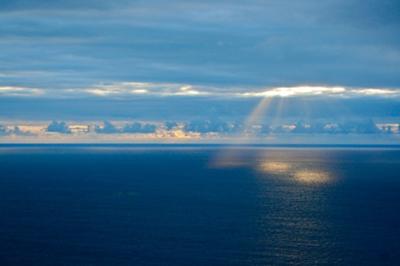Sao Jorge Sojourn
by Mike Geniella
(Mendocino County, California, US)

Picture from Sao Jorge
SAO JORGE - It’s a warm and gray morning. A blanket of clouds covers the Azores, casting a blue-gray shadow across the Atlantic.
Some clouds creep slowly across the flanks of the towering volcano on the nearby island of Pico. A few appear anchored to the mountain’s peak. Clouds partially obscure the coastline of Faial, the other nearby island visible from the front porch of my cousin Paula’s holiday house near the village of Urzelina on the coast of Sao Jorge island.
My desk this morning is an old lava grist wheel placed horizontally on a steel post at the porch’s edge. The laptop’s clock is based on California time, and shows 1:45 a.m. But my mind and body after 10 days know it’s seven hours later here in the Azores, a nine-island archipelago 900 miles off the coast of Portugal.
What I write this morning comes haltingly, my thoughts as uncertain as the day about to unfold. It is the eve of our final weekend in this timeless place.
The past is everywhere. My grandfather’s family has lived on Sao Jorge since the 1500s. Our ancestors were among the “First Settlers,” a hardy group of Portuguese and Flemish people who carved out new lives on a cluster of previously unpopulated islands.
The settlers built houses from lava stones, and cleared land to grow yams, grapes, wheat and potatoes in a temperate maritime climate. On Sao Jorge, the earliest settlers harvested native plants for dyes to be used in Flemish tapestries. Over time the settlers experimented with a variety of agricultural pursuits until largely settling on producing milk from dairy cows to make a tangy Sao Jorge cheese that is now the dominant export.
Airports and greatly improved harbors in the last 50 years have ended centuries of isolation for the Azores, a self-governing island group under the Portuguese flag.
Still the islands remain rooted in their traditions, and a culture linked to the Portuguese mainland but uniquely its own.
Change comes slow. A fledgling eco-tourist movement focusing on spectacular hiking trails, whale and porpoise watching, and underwater exploration in the deep Atlantic is stalled by global economic uncertainty. The visitor count is off 15 percent this year, according to recent government figures.
Those who come discover what Azoreans have always cherished – quaint towns, incredibly beautiful landscapes, and dramatic coastlines caressed by the deep blue Atlantic. National Geographic magazine two years ago ranked the Azores the second most unblemished chain of islands in the world.
Sons Luke and Sam this year joined me for a return visit, and since late June we’ve roamed familiar places on Sao Jorge we saw on our first visit last year. We are awed now as then.
At dusk Thursday we drove down a narrow dirt road to the very northern tip of Sao Jorge and an abandoned lighthouse at Ponta dos Rosais. The road slices through lush pastureland crisscrossed by miles of lava stone walls and hedges of blooming blue and white hydrangeas. The pastoral beauty is overwhelming. Besides the occasional herd of dairy cows it is all ours.
At Ponta dos Rosais, the island narrows into a ragged point resembling an arrow head. A sweeping view of the Atlantic underscores how Sao Jorge and the other islands are lonely volcanic outposts, the last between here and the North American continent.
A narrow band of light from the setting sun glistens on the horizon, and separates the calm ocean surface from dark, brooding clouds gathering above. Unexpectedly a golden shaft of light breaks through the cloud cover, illuminating a small patch of the ocean surface. It is truly one of nature’s great moments.
On our return drive to the port town of Velas, we marvel at the island’s beauty, its warm and welcoming people and a pace of life we find so appealing.
Mendocino County is my home, but I’m more aware then ever of the strong pull my Sao Jorge heritage has on my soul. I’m at peace here in ways that are difficult to explain.
We’re still five days from departure but those mysterious feelings the Portuguese call “saudade” are stirring. Saudade is something described as a “vague and constant desire for something that does not and probably cannot exist…a turning towards the past or towards the future.”
My grandfather left this island for America more than a century ago, and he never returned. My father was a native Californian. So am I. My wife Terese and our sons too.
Still, I ask: How can I feel such longing for a life I’ve never lived?
Rob's Reply
Thank you for that wonderful note! Beautifully written. You truly understand the Azores experience.
Please write again any time you like
Rob Belchior

